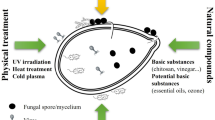Abstract
Objectives
To study enhanced barley germination by chitooligosaccharide as an elicitor for improving the quality of malt.
Results
Barley germination for both radical and leaf sprouts was enhanced when chitooligosaccharide was added to the steeping water in the first steeping cycle. The activities of hydrolases (α-/β-amylase, proteinase and β-glucanase) and antioxidases (superoxide dismutase and catalase) in the resultant malt were increased in a dose-dependent manner when chitooligosaccharide was supplemented in the steeping water. Maximal promotion was at 1 mg chitooligosaccharide/l for α-/β-amylase and proteinase, and at 10 mg/l for β-glucanase, superoxide dismutase and catalase. Malt quality, including free α-amino nitrogen content, Kolbach index, malt extract content, diastatic power, wort viscosity and the ratio of glucose, maltose and maltotriose, was significantly improved by chitooligosaccharide in seed priming at 1 mg/l.
Conclusion
Application of chitooligosaccharide in the steeping water promotes barley germination and improves the quality of malt.




Similar content being viewed by others
References
Cote F, Hahn MG (1994) Oligosaccharins: structures and signal transduction. Plant Mol Biol 26:1379–1411
de Sá RM, Palmer GH (2004) Assessment of enzymatic endosperm modification of malting barley using individual grain analyses. J Inst Brewing 110:43–50
Duval EH, Alves SL Jr, Dunn B, Sherlock G, Stambuk BU (2010) Microarray karyotyping of maltose-fermenting Saccharomyces yeasts with differing maltotriose utilization profiles reveals copy number variation in genes involved in maltose and maltotriose utilization. J Appl Microbiol 109:248–259
European Brewery Convention (EBC) (2004) Analytica-EBC. Verlag Hans Getränke-Fachverlag, Nürnberg
Hameed A, Sheikh MA, Hameed A, Farooq T, Basra SMA, Jamil A (2013) Chitosan priming enhances the seed germination, antioxidants, hydrolytic enzymes, soluble proteins and sugars in wheat seeds. Agrochimica 67:32–46
Hattingh M, Alexander A, Meijering I, van Reenen CA, Dicks LMT (2014) Malting of barley with combinations of Lactobacillus plantarum, Aspergillus niger, Trichoderma reesei, Rhizopus oligosporus and Geotrichum candidum to enhance malt quality. Int J Food Microbiol 173:36–40
Jamar C, du Jardin P, Fauconnier ML (2011) Cell wall polysaccharides hydrolysis of malting barley (Hordeum vulgare L.): a review. Biotechnol Agron Soc Environ 15:301–313
Jin Z, Cai GL, Li XM, Gao F, Yang JJ, Lu J, Dong JJ (2014) Comparative proteomic analysis of green malts between barley (Hordeum vulgare) cultivars. Food Chem 151:266–270
Katiyar D, Hemantaranjan A, Singh B (2015) Chitosan as a promising natural compound to enhance potential physiological responses in plant: a review. Ind J Plant Physiol 20:1–9
Kreisz S (2009) Malting. In: Esslinger HM (ed) Handbook of brewing: processes, technology, markets. Wiley-VCH, Weinheim, pp 147–164
Lodhi G, Kim YS, Hwang JW, Kim SK, Jeon YJ, Je JY, Ahn CB, Moon SH, Jeon BT, Park PJ (2014) Chitooligosaccharide and its derivatives: preparation and biological applications. Biomed Res Int 2014:654913
Ma LJ, Li YY, Wang LL, Li XM, Liu T, Bu N (2014) Germination and physiological response of wheat (Triticum aestivum) to pre-soaking with oligochitosan. Int J Agric Biol 16:766–770
McCleary BV, Codd R (1989) Measurement of β-amylase in cereal flours and commercial enzyme preparation. J Cereal Sci 9:17–33
Yin H, Bai XF, Du YG (2008) The primary study of oligochitosan inducing resistance to Sclerotinia scleraotiorum on B. napus. J Biotechnol 136:S600–S601
Acknowledgments
This research was supported by the National Natural Science Foundation of China (31401681 and 31371742), the Special Funding for Agroscientific Research in the Public Interest (201303095) and the National Spark Program (2015GA650004).
Author information
Authors and Affiliations
Corresponding author
Ethics declarations
Conflict of interest
The authors declare that they have no conflict of interest.
Rights and permissions
About this article
Cite this article
Lan, W., Wang, W., Yu, Z. et al. Enhanced germination of barley (Hordeum vulgare L.) using chitooligosaccharide as an elicitor in seed priming to improve malt quality. Biotechnol Lett 38, 1935–1940 (2016). https://doi.org/10.1007/s10529-016-2181-5
Received:
Accepted:
Published:
Issue Date:
DOI: https://doi.org/10.1007/s10529-016-2181-5




